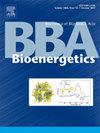Structural study of the chlorophyll between Lhca8 and PsaJ in an Antarctica green algal photosystem I-LHCI supercomplex revealed by its atomic structure
IF 2.7
2区 生物学
Q2 BIOCHEMISTRY & MOLECULAR BIOLOGY
引用次数: 0
Abstract
Coccomyxa subellipsoidea is an oleaginous, non-motile unicellular green microalga isolated from Antarctica, and is an attractive candidate for CO2 fixation and biomass production. C. subellipsoidea is the first polar green alga whose genome has been sequenced. Understanding the structure of photosystems from C. subellipsoidea can provide more information about the conversion of light energy into chemical energy under extreme environments. Photosystems I (PSI) is one of the two photosystems highly conserved from cyanobacteria to vascular plants, and associates with a large amount of outer light-harvesting complex (LHC) which absorb light energy and transfer them to the core complex. Here, we determined the structure of the PSI-10 LHCIs and PSI-8 LHCIs supercomplexes from C. subellipsoidea at 1.92 Å and 2.06 Å resolutions by cryo-electron microscopy, respectively. The supercomplex is similar to PSI-LHCI from other green algae, whereas a large amount of water molecules is observed in our structure because of the high-resolution map. Two novel chlorophylls (Chls), Chl a321 in Lhca4 and Chl a314 in Lhca8, are observed at the lumenal side in our structure, in which Lhca8-Chl a314 provides a potential excitation energy transfer (EET) pathway between the inner-belt of LHCI and the core at the lumenal side. A total of three major EET pathways from LHCIs to PSI core are proposed, and C. subellipsoidea might adapt to the extreme environment by transferring energy in these three different EET pathways instead of by two major pathways proposed in other organisms.
南极绿藻光系统I-LHCI超配合物中Lhca8和PsaJ之间叶绿素的结构研究
Coccomyxa subbellipsoidea是一种从南极洲分离出来的产油、不活动的单细胞绿色微藻,是一种有吸引力的二氧化碳固定和生物质生产的候选藻类。C. subbellipsoidea是第一个基因组测序的极地绿藻。了解C. subbellipsoidea光系统的结构可以提供更多关于极端环境下光能转化为化学能的信息。光系统I (PSI)是蓝藻到维管植物中高度保守的两个光系统之一,它与大量的外部光收集复合体(LHC)有关,该复合体吸收光能并将其转移到核心复合体。在这里,我们用低温电子显微镜分别测定了C. subellipsoidea中PSI-10 LHCIs和PSI-8 LHCIs超配合物在1.92 Å和2.06 Å分辨率下的结构。该超复合物与其他绿藻的PSI-LHCI相似,而由于高分辨率的图谱,在我们的结构中观察到大量的水分子。在我们的结构中,在管侧观察到Lhca4中的Chl a321和Lhca8中的Chl a314两种新的叶绿素,其中Lhca8-Chl a314在LHCI内带和管侧核心之间提供了一个潜在的激发能传递(EET)途径。从lhci到PSI核心,C. subbellipsoidea可能通过这三种不同的EET途径来适应极端环境,而不是其他生物提出的两种主要的EET途径。
本文章由计算机程序翻译,如有差异,请以英文原文为准。
求助全文
约1分钟内获得全文
求助全文
来源期刊

Biochimica et Biophysica Acta-Bioenergetics
生物-生化与分子生物学
CiteScore
9.50
自引率
7.00%
发文量
363
审稿时长
92 days
期刊介绍:
BBA Bioenergetics covers the area of biological membranes involved in energy transfer and conversion. In particular, it focuses on the structures obtained by X-ray crystallography and other approaches, and molecular mechanisms of the components of photosynthesis, mitochondrial and bacterial respiration, oxidative phosphorylation, motility and transport. It spans applications of structural biology, molecular modeling, spectroscopy and biophysics in these systems, through bioenergetic aspects of mitochondrial biology including biomedicine aspects of energy metabolism in mitochondrial disorders, neurodegenerative diseases like Parkinson''s and Alzheimer''s, aging, diabetes and even cancer.
 求助内容:
求助内容: 应助结果提醒方式:
应助结果提醒方式:


